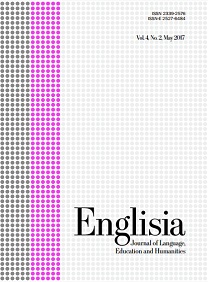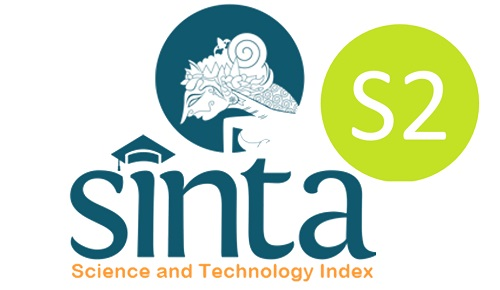Textual and linguistic characteristics in ELT research article abstracts: Insights from Indonesian novice writers
DOI:
https://doi.org/10.22373/ej.v12i2.28747Keywords:
abstract, applied linguistics, linguistics features, rhetorical moveAbstract
In academic writing, particularly in research article abstracts, rhetorical moves and linguistic features are pivotal for effectively communicating findings to a broad audience. This study explores the rhetorical moves employed by Indonesian novice writers in their research article abstracts and their linguistic realization. Using a descriptive qualitative design, we analyzed 25 English Language Teaching (ELT) abstracts written by Indonesian novice writers, employing a checklist instrument for data collection. The results indicate that purpose and product moves are obligatory, method and conclusion moves are conventional, and introduction moves are optional. Rhetorical patterns predominantly follow a linear structure, with embedded and less frequent moves occurring less often. Linguistically, active voice prevails across all moves, surpassing passive voice usage. Present tense is the most common, followed by past, perfect, and future tenses. Key interactional metadiscourse devices, including hedges, boosters, and attitude markers, are evident, while engagement markers and self-mentions are notably absent. This study underscores variations in rhetorical structures and linguistic features among Indonesian novice writers, offering insights to enhance their academic writing practices.Downloads
References
Amalia, S., Kadarisman, A., & Laksmi, E. D. (2018). The Rhetorical Moves in Indonesian EFL Thesis Abstracts across Educational Levels. Jurnal Pendidikan Humaniora, 6(2), 99–107.
Amnuai, W. (2019). Analyses of Rhetorical Moves and Linguistic Realizations in Accounting Research Article Abstracts Published in International and Thai-Based Journals. Sage Open, 9(1). https://doi.org/10.1177/2158244018822384
Amnuai, W., Kotuta, P., & Duangprasertchai, M. (2020). Textual and Linguistic Characteristics of Research Article Abstracts. LLT Journal: A Journal on Language and Language Teaching, 23, 168–181. https://doi.org/10.24071/llt.v23i1.2407
Arsyad, S. (2014). The Discourse Structure and Linguistic Features of Research Article Abstracts in English by Indonesian Academics. Asian ESP Journal, 10(2), 191–223.
Arsyad, S., & Arono. (2018). Memahami Dan Menulis Abstrak Artikel Jurnal. Halaman Moeka Publishing.
Astria, H., Arsyad, S., & Diani, I. (2023). Rhetorical Moves and Linguistic Features of Research Article Abstracts by Indonesian Authors in Applied Linguistics Published in National Journal. Edu-Ling Journal, 7(1), 30–41. https://journals.unihaz.ac.id/index.php/edu-ling
Banks, D. (2017). The Extent to Which the Passive Voice Is Used in the Scientific Journal Article, 1985–2015. Functional Linguistics, 4(12), 1–17. https://doi.org/10.1186/s40554-017-0045-5
Belcher, W. L. (2019). Writing Your Journal Article in Twelve Weeks A Guide to Academic Publishing Success Second edition. University of Chicago Press.
Ebadi, S., & Zamani, G. (2016). Move Analysis of the Conclusion Sections of Research Papers in Persian and English. Cypriot Journal of Educational Sciences, 11(1), 9–20.
Flowerdew, J. (2013). Discourse in English Language Education. Routledge. https://doi.org/10.4324/9780203080870
Gani, F. G., & Kurniawan, E. (2021). A Comparative Study of Rhetorical Moves and Linguistic Features of Lecturers’ Theses and Dissertations Abstracts in Soft and Hard Science. Passage, 9(2), 35–55.
Gillaerts, P., & Velde, F. Van de. (2010). Interactional Metadiscourse in Research Article Abstract. Journal of English for Academic Purposes, 9(1), 128–139. https://doi.org/10.1016/j.jeap.2010.02.004
Hakim, H., Arsyad, S., & Syahrial, S. (2021). Rhetorical Moves and Linguistic Realizations of Research Article Abstracts by Indonesian Authors in Applied Linguistics Published in International Journals. JOALL (Journal of Applied Linguistics and Literature), 6(1), 46–71. https://doi.org/10.33369/joall.v6i1.11800
Hanidar, S. (2016). Rhetorical Patterns, Verb Tense, and Voice in Cross Disciplinary Research Article Abstract. Jurnal Humaniora, 28(1), 12–27. https://doi.org/10.22146/jh.v28i1.11410
Herlyna, H., Ramadhina, R., & Romla, R. (2024). Rhetorical Moves in Students’ Abstracts. JELL (Journal of English Language and Literature), 9(02), 283–290. https://doi.org/10.37110/jell.v9i02.249
Hidayatullah, E. P., & Hati, G. M. (2017). Subject-Verb Agreement Errors Made by Sixth Semester English Education Students. Journal of English Education and Teaching (JEET), 1(1), 21–34.
Hopkins, D., & Cullen, P. (2007). Grammer For IELTS With Answers. Cambridge University Press.
Hyland, K. (2004). Disciplinary Discourses: Social Interactions in Academic Writing. University of Michigan Press. https://doi.org/10.3998/mpub.6719
Hyland, K. (2018). Metadiscourse: Exploring Interaction in Writing. Bloomsbury Academic.
Indrian, R., & Ardi, P. (2019). Rhetorical Structures of English-Major Undergraduate Thesis Introduction Chapters. Indonesian Journal of EFL and Linguistics, 4(2), 195–214. https://doi.org/10.21462/ijefl.v4i2.166
Irmawan, N. (2017). Verb Tense Analysis of Research Article Abstracts in Asian Efl Journal. Progressive, 12(2), 57–64.
Kanafani, A., Nurcik, A., Harisbaya, A., Qurratu’aini, S., Kurniawan, E., & Lubis, A. (2021). Rhetorical Move and Linguistic Features Comparative Analysis of Research Article Abstracts by Authors of Different Organizational Backgrounds. Proceedings of the Fifth International Conference on Language, Literature, Culture, and Education, 129–135. https://doi.org/10.2991/assehr.k.211119.021
Kanoksilpatham, B. (2007). Rhetorical Moves in Biochemistry Research Articles. In Discourse on the Move (pp. 73–119). John Benjamins Publishing Company. https://doi.org/10.1075/scl.28.06kan
Kaya, F., & Yağız, O. (2023). Developing and Evaluating an Online Professional Development Model on Academic Writing Conventions and Norms in English. Sage Open, 13(4). https://doi.org/10.1177/21582440231212786
Khatri, B. B. (2022). Writing an Effective Abstract for a Scientific Paper. Nepalese Journal of Development and Rural Studies, 19(1), 1–7. https://doi.org/10.3126/njdrs.v19i01.51910
Kumar, M. J. (2018). Abstracts are Windows to Your Research Article: What Makes Them Good? IETE Technical Review, 35(1), 1–2. https://doi.org/10.1080/02564602.2018.1407056
Kurniawan, E., & Sabila, N. (2021). Another Look at the Rhetorical Moves and Linguistic Realizations in International and Indonesian Journal Articles: A Case of Tourism Research. Indonesian Journal of Applied Linguistics, 11(2), 318–329. https://doi.org/10.17509/ijal.v11i2.32055
Lorés-Sanz, R. (2004). On RA abstracts: From Rhetorical Structure to Thematic Organisation. English for Specific Purposes, 23(1), 280–302. https://doi.org/10.1016/j.esp.2003.06.001
Lövei, G. (2021). Writing and Publishing Scientific Papers: A Primer for the Non-English Speaker. Open Book Publishers. https://doi.org/10.11647/OBP.0235
McNamara, D., & Mccarthy, P. (2010). Linguistic Features of Writing Quality. Written Communication, 27(1), 57–86. https://doi.org/10.1177/0741088309351547
Muangsamai, P. (2018). Analysis of Moves, Rhetorical Patterns and Linguistic Features in New Scientist Articles. Kasetsart Journal of Social Sciences, 39(2), 236–243. https://doi.org/https://doi.org/10.1016/j.kjss.2018.03.006
Nikpei, H. (2016). Rhetorical Moves of Abstracts Written by TEFL Students and Molecular Biology Graduate Students-A Comparative Study Hossein Nikpei. International Journal of English Language and Translation Studies, 4(4), 172–179. www.eltsjournal.org
Noortyani, R. (2018). An Exploratory Study on Students’ Reading Interest Development through Independent Reading-Retelling Activity. Arab World English Journal, 9(2), 108–117. https://doi.org/10.24093/awej/vol9no2.7
Pratiwi, S., & Kurniawan, E. (2021). Rhetorical Move and Genre Knowledge Development of English and Indonesian Abstracts: A Comparative Analysis. Studies in English Language and Education, 8(3), 885–900. https://doi.org/10.24815/siele.v8i3.21038
Rahmasari, A., Salik, M., & Soraya, I. (2024). Novice Researcher Experiences in Publishing Article A Study at English Education Department UINSA. IJET (Indonesian Journal of English Teaching), 13(1), 40–51.
Refnaldi, R., Irawan, A., Setiawan, S., & Ovalina, S. (2024). Grammatical Subject of Research Articles: What Novice Writers Can Learn from Professional Writers in Writing Introduction? Indonesian Journal of Applied Linguistics, 14(2), 392–405. https://doi.org/10.17509/ijal.v14i2.74905
Soy, S., Arsyad, S., & Syafryadin, S. (2023). The Rhetorical Structure of Review Article Abstracts in Applied Linguistics Published in High-Impact International Journals. Journal of Language and Literature, 23(2), 344–357. https://doi.org/10.24071/joll.v23i2.6128
Suntara, W. (2018). Linguistic Realisations of Rhetorical Structure in Research Articles Abstracts: An Analysis Based on Food Technology Journals. Pertanika Journal of Social Sciences and Humanities, 26(3), 1283–1300.
Tamela, E. (2020). Move Structure Analysis on Research Article Abstracts in National and International SCOPUS Indexed Journals. Proceedings of the International Conference on English Language Teaching (ICONELT 2019), 12–17. https://doi.org/10.2991/assehr.k.200427.004
Tu, P.-N., & Wang, S.-P. (2013). Corpus-based Research on Tense Analysis and Rhetorical Structure in Journal Article Abstracts. Proceedings of the 27th Pacific Asia Conference on Language, Information, and Computation (PACLIC 27), 102–107.
Zhang, J., Lee, J., & Wilde, J. (2012). Metadiscourse to Foster Student Collective Responsibility for Deepening Inquiry. 10th International Conference of the Learning Sciences: The Future of Learning, ICLS 2012 - Proceedings, 1(1), 395–402.
Downloads
Published
Issue
Section
License
Copyright (c) 2025 Zulfikri Malik, Slamet Setiawan

This work is licensed under a Creative Commons Attribution 4.0 International License.
Proposed Policy for Journals That Offer Open Access
Authors who publish with Englisia journal agree to the following terms:
- Authors retain copyright and grant the journal right of first publication with the work simultaneously licensed under a Creative Commons Attribution License that allows others to share the work with an acknowledgement of the work's authorship and initial publication in this journal.
- Authors are able to enter into separate, additional contractual arrangements for the non-exclusive distribution of the journal's published version of the work (e.g., post it to an institutional repository or publish it in a book), with an acknowledgement of its initial publication in this journal.
- Authors are permitted and encouraged to post their work online (e.g., in institutional repositories or on their website) prior to and during the submission process, as it can lead to productive exchanges, as well as earlier and greater citation of published work (See The Effect of Open Access).









